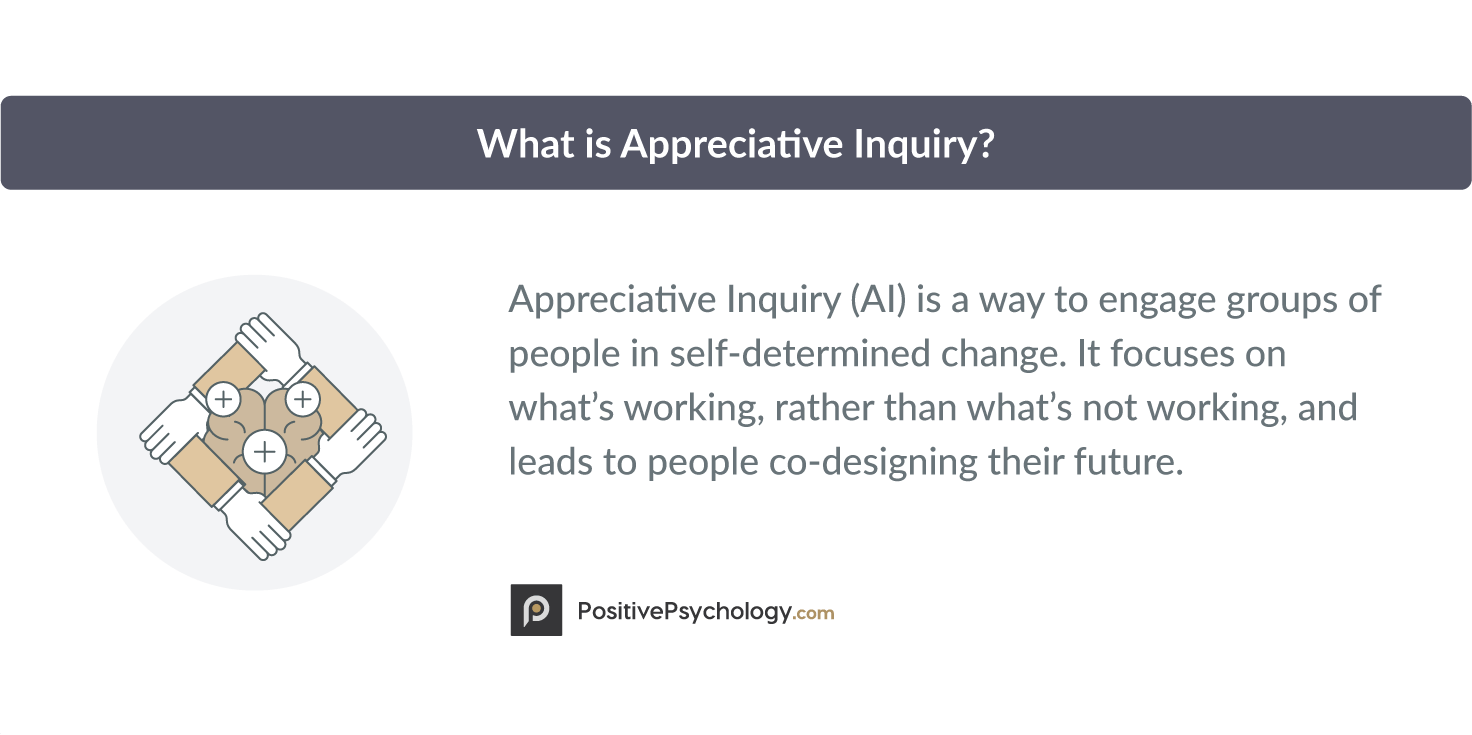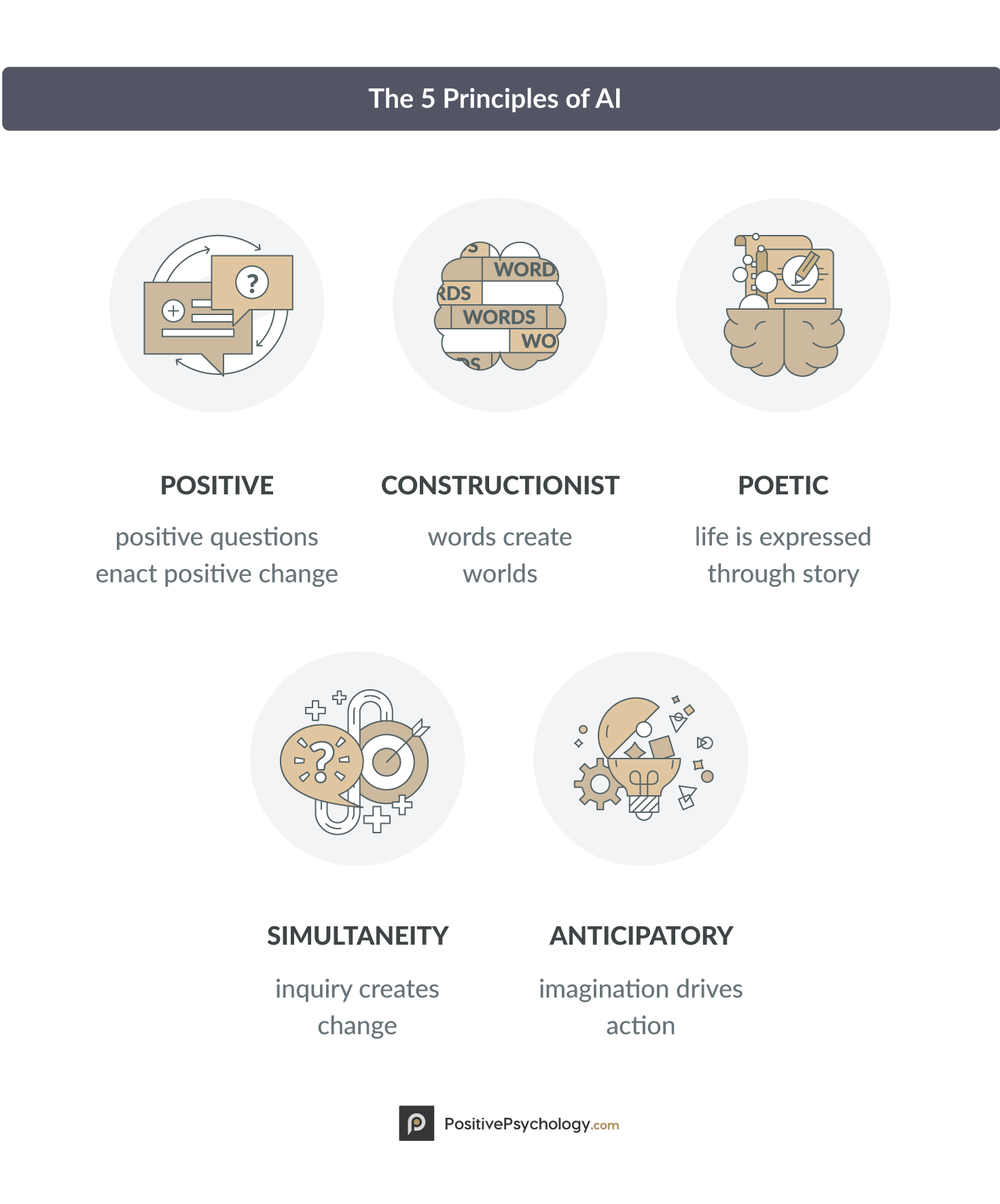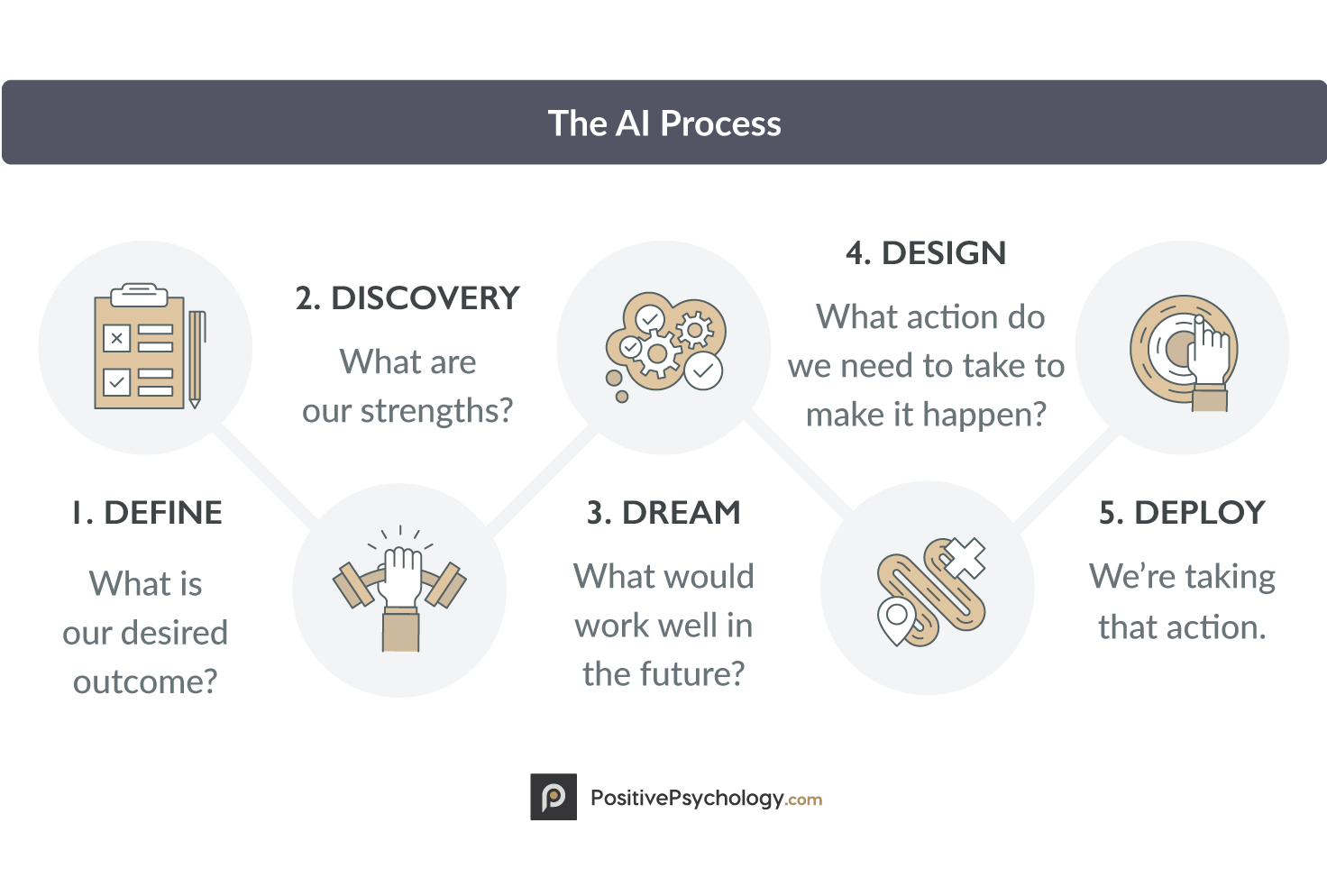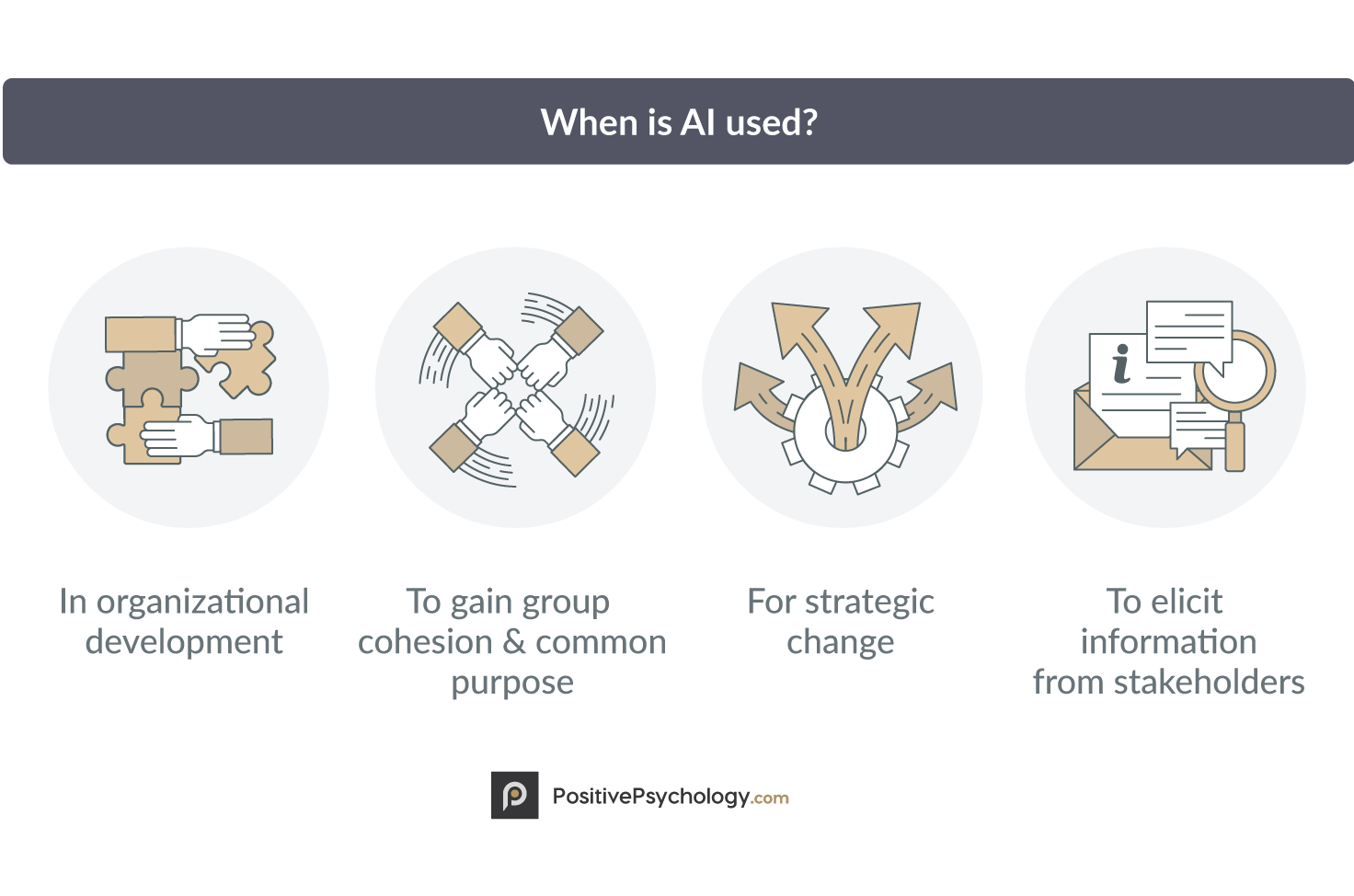How to Apply Appreciative Inquiry: A Visual Guide
 Whether in the context of organizations, healthcare, coaching, or in one’s personal life, challenges invariably always surface.
Whether in the context of organizations, healthcare, coaching, or in one’s personal life, challenges invariably always surface.
The conventional reaction is to coat setbacks in a negative narrative that adopts a deficit-based view and embraces the notion of failure as opposed to that of optimism and improvement.
You have perhaps heard of the expression “Appreciative Inquiry” before, either in another of our articles or elsewhere.
In case you haven’t, Appreciative Inquiry can be described as an approach which draws from positive psychology and storytelling, to create an “alignment of strengths” that render weaknesses irrelevant (Druker in TEDx Talks, 2014), hence empowering individuals and facilitate the resolution of given problems to enact desired change.
Or, in our own words:
While the theory may sound good on paper, putting it into practice may seem a more trying endeavor.
We are here to help, advise and guide you through the different steps involving the Appreciative Inquiry approach, which should, in turn, enable you to succeed at preventing and surmounting challenges whilst espousing a positive and stimulating outlook.
Before you continue, we thought you might like to download our three Positive Psychology Exercises for free. These science-based exercises will explore fundamental aspects of positive psychology including strengths, values, and self-compassion, and will give you the tools to enhance the wellbeing of your clients, students, or employees.
This Article Contains:
The Appreciative Inquiry Process
The notion of “Appreciative Inquiry” traces its roots back to the eighties, when David Cooperrider and Shuresh Srivastva at Case Western Reserve University sought to challenge the traditional approach to problem-solving in the organizational setting.
The main argument for this shift was a human one.
As Hammond writes (2013), the traditional approach was “consistent with a historical attitude in American business that see human systems as machines and parts (people) as interchangeable”.
They claimed to believe that they could “fix anything and there is a right answer or solution to any organizational problem or challenge”.
Indeed, traditionally, the procedure for enacting change typically would consist in first pinpointing a specific issue, analyze the source, find a remedy for it and put into place a possible action plan.
Instead of looking out for positive elements that may enable a situation to move forward, the general focus would then generally be set on failure, broken, needing reparation.
The primary flaw of this approach has been that focusing on problems leads to their amplification, which can have a plethora of consequences, by eroding the energy, benevolence, and motivation of those involved.
Encouraging Exploration
As opposed to solely focusing on the drawbacks of the situation, thus, the newly developed concept of Appreciative Inquiry consisted of encouraging the exploration of already-existing strengths and successes of either organizations or of individuals, to instigate positive change.
In the developing of Ai, (in scientific literature and in this article, “Appreciative Inquiry” is shortened to “Ai”, so that a clear distinction between Ai and AI -artificial intelligence- is maintained) Cooperrider was also influenced by research findings emanating from the fields of medicine, sports, behavioral sciences, and anthropology, that provided evidence in support of the claim that positive images can have a tremendous power on human psychology (Mishra & Jyotsna Bhatnagar, 2012).
A groundbreaking discovery was the “placebo effect”, in the context of a study that revealed that between one and two-thirds of group patients who unknowingly, had been administered a placebo and believed instead that they were given proper medication, showed a significant improvement in the given symptoms of their illness (ibid).
Another emerged from the Pygmalion studies, which revealed that the very image teachers have of their students impact the performance levels of these as well as their future prospect.
Finally, another demonstrated how positive and negative thinking could impact surgical outcomes. It was found that patients whose thoughts tended to be more positive in fact recovered much faster than their counterparts (Cooperrider and Whitney, 2000).
As it was applied in real-world studies, the approach quickly yielded remarkable performance and outputs, triggered by the creation of a sense of shared vision and direction, the strengthening of bonds between co-workers, as well as an energetic feeling of common identity.
Given that Cooperrider was described by Waddock (2015) as an “intellectual shaman”, that is, a “scholar who becomes fully who they must be, and find and live their purpose, to serve through three capacities: healing, connecting, and sensemaking, and in the process seek or come to wisdom”, the results only make sense.
The relevance of Ai saw itself go well beyond the realm of corporate strategy, as the backbone of the paradigm also yielded outstanding results in other life domains.
Indeed, Appreciative Inquiry has henceforth been practically implemented in the context of leadership coaching, to help individuals realize their “personal strategic vision” (Benedictine University, 2017).
On the societal level, Ai has been instrumentalized to find points of convergence in international affairs, to give direction to NGO’s and non-profits, as well as global initiatives (ibid).
But first, let’s break down the theoretical underpinnings of Ai and its relevance to the field of positive psychology.
A Look at the Principles
Cooperrider’s approach was informed by the social constructionist approach by highlighting the role of conversations, imagination, and general social dynamics in articulating the “collective design” of a given organization.
Hence, the Core Principles of Appreciative Inquiry strand of thought were set by Cooperrider and Suresh Srvastva, his advisor, to be “Constructionist, Simultaneity, Anticipatory, Poetic, and Positive” (Ai Commons, 1999).
These five different principles have their own philosophical underpinnings, which play a key function in the way people frame issues to themselves and the direction they take to resolve them.
Drawing from the Ai Commons website, we have squeezed them together, along with their definitions and respective takeaway messages that may be applied when faced to a range of different challenges.
As Hammond reminds us (2013), “unlike a cookbook approach to change, Ai is a thought process – a way to approach change”.
Core principle – Constructionist
What it means – “Words create worlds”
People construct their understanding of reality through language and conversations. Reality is therefore subjective, not objective. Here, the narrative one has of oneself often is resorted to in order to justify certain actions and beliefs about the world. In other words, Ai is said to “treat social-psychological reality as a product of the moment, open to reconstructions” (Mishra & Jyotsna Bhatnagar, 2012).
Core principle – Simultaneity
What it means – Inquiry creates change
Questions hold the potential to trigger immediate change. For instance, asking -with genuine curiosity and interest- why a person operates in a given way, will likely have a thought-provoking effect on the interlocutor. Alone, the person will begin to reflect on whether there are better, faster, and less stressful ways of proceeding with things. This created a momentary sense of openness encourages self-improvement and reflexivity.
Core principle – Poetic
What it means – Life is expressed through story
Life can be understood as though it is a narrative. Like poetry and prose, these narratives ignites creativity and is interpreted differently by different people. Considering life in this way creates space to allow the processing of subjective feelings and emotions surrounding a situation, not just the gritty facts, in the same way that one does when taking in a poem or story.
Core principle – Anticipatory
What it means – Imagination drives action
A vivid image of an internalized goal or vision is what inspires and motivates people to do things and improve themselves. If the image is framed in a positive and powerful fashion, it is likely that it will have a strong positive effect on an individual’s present and the next moves he will make. To add more practical detail to this point, Locke’s goal-setting theory may come in handy.
Core principle – Positive
What it means – Positive questions enact positive change
The positive principle is about the emotional context in which the goal is framed. As such, encouragement, personal support and other forms of positive affect can have a pivotal effect on the way in which a person goes about enacting change. Even acknowledging and feeling grateful for the mere presence of others in one’s life can strengthen the extent to which a person feels empowered to embrace growth.
The Appreciative Inquiry Steps
In A Positive Revolution in Change (2001), Cooperrider writes:
“In Ai the arduous task of intervention gives way to the speed of imagination and innovation. Instead of negation, criticism, and spiraling diagnosis, there is discovery, dream, and design.
Ai seeks fundamentally to build a constructive union between a whole people and the massive entirety of what people talk about as past and present capacities: achievements, assets, unexplored potentials, innovations, strengths, elevated thoughts, opportunities, benchmarks, high point moments, lived values, traditions, strategic competencies, stories, expressions of wisdom, insights into deeper corporate spirit or soul- and visions of valued and possible futures”.
The principal way in which Ai breaks away from traditional problem-solving methods lies in its capacity to shift the attention given to underperformance, failure and lack of motivation, to developing a deeper and constructive understanding of a person’s experience of being human.
Helping a person navigate the waters of their own positive memories, their values, hopes and ambitions can be extremely rewarding, not only for his interlocutor but for the person themselves, and unlock new trajectories for the unleashing of their potential.
According to Mohr & Magruder Watkins’s “Roadmap for Creating Positive Futures”, there are five main steps that can be taken in order to tackle and address a given issue within a framework of Appreciative Inquiry.
These are:
The authors stress that the different steps are intentionally generic- so that the essence of what Ai is about is kept while also demonstrating flexibility regarding the applicability of its ideas.
Here, it is important to note that each process forms part of a larger whole and overlaps with another process -take, for example, point 2 and 3 which overlap in the ‘discovery’ dimension.
The first step is to define what specifically is desired, in relation to an already-existing positive feature of a person or organization.
Knowing what is sought facilitates the outlining of the purpose of the project, its content, and the measures that need to be taken in order to achieve desired results.
Guiding Appreciative Inquiry questions that may be used to delineate the object of inquiry can be:
- What positive element am I looking to develop?
- How can we achieve this together?
The second involves appreciating the other’s experiences and explore their own account of their strengths and successes and how they feel about them. Discovering -through conversation- what works for them and makes them tick can be a stepping stone towards change.
The third step entangles the shared experiences of both interlocutors to discuss experiences that inspired, stimulated and motivated them. Referring to the past in order to broaden the range of possibilities in the present and future is an effective method that appeals to the emotions of the persons involved.
Still, in the spirit of a positive exchange, the fourth step involves identifying one another’s dreams and looking into personal positive assets may be instrumentalized in light of reaching a given goal, in the context of a creative and empathetic conversation.
The fifth step shifts the dream to reality and aims to determine what should be aimed for, most optimistically, based on uncovered capacities, to set up an ideal picture of what the future could look like.
Following, the idea is to identify what can be concretely done to ‘deliver’ ideal results and set a plan for a given time span.
In What Ways Can Ai be Applied?
Ai can be used in a range of contexts, on a one-to-one basis as well as bigger groups, in person or virtually.
It is also effective when used in major initiatives involving thousands of people.
In other words, there are no specific restrictions that limit the applicability of Ai and its effectiveness.
Positive psychology holds close bonds with Ai, in that both hold at heart the positive over the negative, the potential of a person over his or her crippling defects, as well as the future as opposed to the past.
Further, both restore the locus of agency in the hands of the individual, by enabling him to reframe his personal narrative and grow as a person through challenges.
Nothing is ever determined, and every situation offers possible routes for self-improvement, development, and happiness.
Ai can even trickle down into our social lives, and the way in which we interact with close loved ones as well as with strangers, and how we may bond with them.
Stratton-Berkessel, in the following TED Talk, gives a compelling example of the way in which these can be applied and their potential impact on relatedness and the wealth of emotions that may ensure its application.
Stressing that ‘words create worlds’, she claims that the way we frame what we want to talk about has a major effect in shaping the content and type of exchange that ensues.
For example, Stratton-Berkessel presents the common situation in which, a father goes to pick up his son at school and asks him how his day went, expecting a conversation to follow.
The father asks: “what happened at school today, son?”
Typically, the son answers “nothing, not much”, marking the end of the conversation.
The next day, the father decides to change the question to: “Son, what’s the best thing that happened today at school?”, only to be told a completely different story.
Hence, asking people “what is the best thing that has happened to you today” is not only a fantastic icebreaker but also, can serve as a bridge to connect the shared spectrum of emotions that shape the experience of others, leading to “increased understanding, greater tolerance, as well as heartfelt connections” (ibid).
Ai, she argues, triggers a ricochet that may allow fourteen positive emotions to surface in one single conversation:
The act of asking something positive, she says, first brings out joy and delight, followed by feelings of kindness, curiosity towards the person one is interacting with, as well as of courage (perhaps because of the anticipation felt prior to asking such a personal question).
Receiving a positive and communicative answer, in turn, brings about a sense of relief and respect towards the other.
As the conversation unfolds, the two people then experience gratitude, interest in one another’s shared stories, that finds itself substantiated by a sense of connection and relatedness.
The bond deepens, and as both feel more comfortable with one another, the conversation takes a more playful turn, which reinforces the positive perception they have of each other, and results in a sense of awe.
Finally, the take away of the social exchange is love, the final outcome of the intermeshing of all the experienced emotions felt into one and outshines the initial differences and lack of interest in one another that may have led to indifference and kept the status quo in its place.
Relevantly, Meg Wheatley beautifully wrote the following lines:
“You don’t fear people
Whose story you know
Real listening always brings people closer together.
Trust that meaningful conversations can change your world.
Rely on human goodness.
Stay together”.
Taking these wise words on board, the bottom line is that positive verbal approaches and spirit tend to lead to the generation of more positive energy and strength that serves to overcome existing drawbacks.
Hence, the method is also applicable to one’s personal life and can be useful when one is going through difficult times or facing a challenging problem.
Equipped with a pen and a piece of paper -or a laptop-, you may want to dwell on the following listed questions by Duesterhoft (2012) and formulate replies to yourself, either verbally or in written form.
Doing so will enable you to take perspective on your situation, not lose track of the efforts you have made to reach where you are today and remind yourself of other positive aspects of your life and personality that may have been overshadowed by the darkness of a negative phase.
Indeed, gratefulness and a re-assessment of one’s value can prove itself to be an effective self-esteem boost, resulting in empowerment and self-love.
- What is it that you love the most about your personal life or career?
- What is it that fundamentally drives you in life, and persist in your career or personal endeavors?
- What talents do you have that you are most grateful for?
- How have they helped you get where you are today?
- What influences have inspired you throughout your life? In what ways have they provided you with existential guidance and a mental framework to develop your best self?
- What purpose do you most wish to fulfill in your career or personal life?
- What is it that you can start doing today that will increase the likelihood of making these wishes come true?
Often people put themselves down and feel insecure because they are not enough reminded -or don’t remind themselves frequently enough- of their worth and the value of their achievements.
They become paralyzed by the negative thoughts that eventually come to shape their entire view on reality, which can create great damage as insecurities cannot simply be addressed by “I have X insecurity, I must ‘fix’ this by doing X”.
Furthermore, the excessive focus on the problem ends up amplifying the magnitude of the problem itself.
Instead, adopting a strength-based approach and applying to one’s outlook on life can end up resolving concerns by shifting one’s energy and mental processes onto what makes life worthwhile, by exploring the positive one finds in the world and in one’s inner life.
This method, which is forward- and future-looking, can serve as an indispensable tool in challenging moments to stay focused on what matters and stay resilient no matter what.
As the Buddha put it:
“We are what we think. All that we are arises with our thoughts. With our thoughts, we make the world”.
“You can search throughout the entire universe for someone who is more deserving of your love and affection than you are yourself, and that person is not to be found anywhere. You yourself, as much as anybody in the entire universe deserve your love and affection.”
“What we think, we become”.
And from Krishnamurti:
“One is never afraid of the unknown; one is afraid of the known coming to an end.”
How to Best Apply Ai
A common misconception that has damaged Ai’s reputation is that the problem-solving approach dismisses important problems by solely focusing on the positive.
However, and as it was previously emphasized, traditional approaches to problem-solving often fail to bear productive results.
What Ai offers is a possibility to approach systemic issues from a different angle. This has been shown to tackle issues at their root and enable people to be creative in resolving these.
The generation of internal knowledge and new ideas specific to the person or organization is what is sought after in the Ai process. The aim is not to apply externally sourced and predetermined ideas, thereby stripping their sense of agency and personal perspective.
Ai is, therefore, most useful in team building, participatory methods, and giving a clear and positive future direction to the present that was sketched out by all parties involved.
In a case study conducted by Scerri, Innes, and Scerri (2015) among 35 care workers and family members of patients with dementia, for instance, Appreciative Inquiry generated an enhanced understanding of what works best for people whose perspective on the matter would have otherwise not been actively considered.
This exploration of positive care experiences facilitated factors that improved the quality of dementia care services. It also gave outlines for the hospital management for how to improve the way hospital staff incorporate such care methods in their work.
An Ai Case Study
A major success in the implementation’s history of Ai involved the BBC, the British Broadcasting Corporation, which at one point suffered from a culture of excessive competition, mistrust and individualism among its 5,000 employee journalists (Mishra & Bhatnagar, 2012).
While such a culture fostered high creativity levels individually, the non-existent collaborative spirit was having a crippling effect on the profits of the broadcasting service.
In 2002, the director-general, Greg Dyke, decided that it was time for a change and turned to the Appreciative Inquiry approach for guidance.
Through a program entitled “Making It Happen”, which lasted six months and involved 200 meetings at which over 10,000 employees attended around the world, the dysfunctional dynamics were tackled.
In those meetings, employees were teamed up in pairs and told they would take turns in interviewing each other about their respective positive and successful experiences and moments they felt proud of themselves during their time at the BBC.
The questions that formed part of the interview were:
- What have been the most creative/valued experiences in your time at the BBC?
- What were the conditions that made the experience possible?
- If those experiences were to become the norm, how would the BBC have to change?
Following, each pair was placed in smaller groups of ten colleagues, so that the group could discuss and filter out which story they agreed to be most touching and powerful.
The shortlisted stories were then shared with the whole group.
The results were fruitful, as about 98,000 ideas were generated, analyzed and sent to the pan-BBC change team to be evaluated and considered for implementation.
Part of these ideas also included suggestions and observations carried out on the BBC’s value system. These were synthesized and standardized into six aspirational values:
- Trust is the foundation of the BBC: we are independent, impartial and honest.
- Audiences are at the heart of everything we do.
- We take pride in delivering quality and value for money.
- Creativity is the lifeblood of our organization.
- We respect each other and celebrate our diversity so that everyone can give their best.
- We are one BBC: great things happen when we work together.
The framing and implementation of these new values enabled the BBC to develop a new culture and foster a sense of togetherness among its employees.
Appreciative Inquiry Facilitation Guide
Inspired by a training guide for COMPASS (Community Partnerships for Sustainable Resource Management in Malawi, 2003), the following guide outlines how to facilitate social change using Ai.
The person orchestrating the application of Ai is expected to be a facilitator to give direction to the group’s thinking and decision-making processes.
The method used here can also be transposed into other contexts, whether clinical, organizational or else and is likely to bear similar positive results.
- Start off by asking the people present what they would like to discuss and learn about themselves as a collective.
- Encourage them to settle on a topic they are interested in and find important and not something they feel obliged to focus on.
- The choice should be a careful one as once the Ai process has begun, it’s difficult to put aside a given topic from the group’s agenda. Encouraged the group to consider, within a reasonable range, a few ideas.
- Clarity and precision of the topic in question is what should be ultimately strived for.
- The exploration of the choice of focus can be in itself subject to an Ai intervention.
The effectiveness of the Ai process is contingent on the nature of the questions asked- whether they are “fateful”, that is, evocative and generating, or not.
We will cover specific questions in the Appreciative Inquiry Interview Template section of this article. However, here are some points to remember while asking them to substantiate the quality of the answers and improve the chance of positive outcomes.
- Develop tailored positive questions to the group’s desired focus.
- Prolong the conversation by asking “probing questions” to encourage them to get into more detail, inquiry about the different actors involved, the temporality, the reason, and the whys, etc.
- Then, ask the group to frame their successes as a collective, then allow participants to evoke their individual successes.
- Encourage people to verbally relive and share their experiences with the group. The driving idea is to give a central role to storytelling. Open-ended questions will likely prove themselves effective in sparking animated conversation, dialogue, and stories. By contrast, dead-end questions eliciting “yes” or “no” as a response should be avoided.
- The nature of the asked questions should point towards strengthening group cohesion. For instance, ask participants to recall an instance in which the group collaborated and succeeded in achieving something that worked in the interest and benefit of all.
Relevant: 4 Appreciative Inquiry Tools, Exercises and Activities
5 More Tips
1. Provocative propositions
As Cooperrider writes (n.d.) bridging the best of “what is” and “what might be” can be formulated as “provocative propositions”.
It stretches out what is considered possible, implicitly questions taken for granted routines and ways of operating and helps in framing new and desired possibilities for a community to move forward. For this reason, conceptualizing the constructing of provocative propositions as architecture.
The goal is to build something new upon the most solid foundations of your building, in order to enhance its design, functioning, and display.
2. Encouraging phrases
Lewis (2017) highlights the importance of being generous in the emotional interaction with the people Ai is conducted with.
Since the interaction is meant to revolve around them, the way a person emotionally responds to their stories can have a tremendous impact on what they decide to do next or feel about their own ideas.
According to Lewis, “praise and appreciation are an investment, not a cost”, which facilitates a positive psychological disposition that will “boost morale, assist learning, bolster confidence, and improve performance”.
She recommends a ratio of at least 3-1 positive to critical comment will probably improve a person’s sense of wellbeing, his or her engagement, innovation, and creative insights.
Do not hesitate to use encouraging phrases, such as “that’s so interesting! What a good story! That’s a very inspiring experience. Is there anything else you can tell me about this?”.
3. Active listening and engagement
Your interpersonal skills, therefore, play a key role in the Ai process: don’t think of applying Ai interviews as a script- good interviews involve active listening and engagement. Improvising is permitted as long as depth and detail are sought for.
4. Practice
Before applying Ai professionally, Fitzgerald, Murrell, and Newman (2001) advise to start applying the Ai method to yourself and to practice being appreciative of yourself and others.
You may also consider attending an Ai workshop and enrolling in a training program. Study the method in-depth and go back to its foundational works and its most famous applications in the domain you intend to apply it.
Then, come up with personalized questions for Ai interview and try to informally conduct interviews with your family, friends, and co-workers.
5. Consistency and enthusiasm
While conducting Ai, Fitzgerald, Murrell, and Newman (2001) further advice to “let your light shine” and “share your enthusiasm” during the process. Practicing what you preach will therefore also show that you are consistent with Ai principles.
Appreciative Inquiry Interview Template
An Ai interview can serve a range of purposes. A key idea, critical to the successful implementation of the theory, however, is to center the interview around the positive experiences of the interviewee and encourage storytelling.
Indeed, it is important to informally stress that stories are what is expected from the interviewee. Through that medium, people can provide rich answers to inquiries that seek for data about the functioning of their own “systems” (whether personal, communal, organizational or else).
Information that is shared by means of personal stories has also been found to be more accurate, than merely asking them to list their strengths.
The collective surfacing of memory has a multidimensional effect that would not be possible with more linear thinking and engages the imaginations that a more analytical type of exchange would not allow (COMPASS, 2003).
The following interview questions can prove themselves to be effective in understanding not only group dynamics and what domains may necessitate improvement but also, the way a given individual feels about their role in the community, what aspect of it engages them most and their own personal vision for a future direction.
- Can you remember the best moments you have had within your community/group/organization?
- Considering your whole experience, tell me about a time in which you felt most alive, stimulated, engaged or excited about your contribution and involvement. Can you remember in detail what specific factors made it that way? Who was present?
- What are the things that you value most in life? About yourself, your family, your work, and community?
- In your opinion, what is the core life-giving factor or best feature of your community? What is it? Can you think of an even better way of operating for it?
- If you could make three wishes that could potentially improve this community/group/organization, what would they be?
The next questions, in turn, are more general in nature and facilitate the exploration of the inner-workings of a person and what makes them tick:
- Can you recall an instance in your life in which you felt incredibly empowered? How did it happen?
- Tell me in detail about the time in which you faced a challenge to achieve something of high importance. How did you feel?
- Tell us a story about a time when you were really excited to be a part of the group.
- Tell us a story about a time in which your group adopted a new way of doing things and how it helped to achieve something of great importance.
For more Ai interview questions that may be more relevant to your context, you may want to look at this other article published by PPP, which cites over 119 Ai questions.
To read more about how to formulate Ai interviews, the complete COMPASS resource may prove itself useful as it details how to practically implement the different Ai steps with materials, handouts, timeframes, guidelines, and facilitator notes to ease the process.
A Take-Home Message
In this article, I have given an overview of the ways in which the Appreciative Inquiry Process could be applied (for further reading, see these Appreciative Inquiry books). From corporate management, individual psychology to patients with dementia, the options of its application are endless.
There is always something that Ai can do in enabling us to learn how to do things better and tackle problems differently. The model Ai provides is, fundamentally, one that demonstrates the power of positive psychology in practice, and how one’s growth rarely can take place without others, and the recognition of the contribution they make to our lives.
In Stratton-Berkessel’s words:
“When we recognise that what’s good about me, what’s good about you, and what’s good about our entire world, we recognize our self/other begins to overlap.
We realize that we are in this together.
And in the spirit of Ubuntu in Africa, ‘I am because of who we are’.”
We hope you enjoyed reading this article. Don’t forget to download our three Positive Psychology Exercises for free.
- AI Commons. (1999). 5 Classic Principles of AI – The Appreciative Inquiry Commons. Retrieved from https://appreciativeinquiry.champlain.edu/learn/appreciative-inquiry-introduction/5-classic-principles-ai/
- Benedictine University. (2017). What is Appreciative Inquiry? Examples & Resources for the Appreciative Inquiry Process. Retrieved from https://cvdl.ben.edu/blog/what-is-appreciative-inquiry/
- Community Partnerships for Sustainable Resource Management in Malawi (COMPASS). (2003). Introduction to Appreciative Inquiry: Training Manual. COMPASS.
- Cooperrider, D. (n.d.) Tips for Crafting Provocative Propositions – The Appreciative Inquiry Commons. Retrieved from https://appreciativeinquiry.champlain.edu/educational-material/tips-for-crafting-provocative-propositions/
- Cooperrider, D. L., & Whitney, D. (2001). A positive revolution in change: Appreciative inquiry. Public administration and public policy, 87, 611-630.
- Cooperrider, D. L., Peter Jr, F. S., Whitney, D., & Yaeger, T. F. (2000). Appreciative inquiry: Rethinking human organization toward a positive theory of change. Team Performance Management, 6(7-8), 140-140.
- Duesterhoft, M. (2012). Are You Up For A Little Appreciative Inquiry? – PeopleResults. Retrieved from https://www.people-results.com/appreciative-inquiry/
- Fitzgerald, S. P., Murrell, K. L., & Newman, H. L. (2001). Appreciative inquiry: The new frontier. Organization development: Data driven methods for change, 203-221.
- Hammond, S. A. (2013). The thin book of appreciative inquiry. Thin Book Publishing.
- Lewis, S. (2017). 5 Tips for Getting Started with Positive Psychology and Appreciative Inquiry for Change. Retrieved from https://www.koganpage.com/article/5-tips-for-getting-started-with-positive-psychology-and-appreciative-inquiry-for-change
- Mishra, P., & Bhatnagar, J. (2012). Appreciative inquiry: Models & applications. Indian Journal of Industrial Relations, 543-558.
- Mohr, B. J., & Watkins, J. M. (2002). The essentials of appreciative inquiry: A roadmap for creating positive futures. Pegasus Communications, Incorporated.
- Scerri, A., Innes, A., & Scerri, C. (2015). Discovering what works well: exploring quality dementia care in hospital wards using an appreciative inquiry approach. Journal of clinical nursing, 24(13-14), 1916-1925.
- Waddock, S. (2015). Reflections: Intellectual shamans, sensemaking, and memes in large system change. Journal of Change Management, 15(4), 259-273.
Let us know your thoughts
Read other articles by their category
- Body & Brain (49)
- Coaching & Application (57)
- Compassion (26)
- Counseling (51)
- Emotional Intelligence (24)
- Gratitude (18)
- Grief & Bereavement (21)
- Happiness & SWB (40)
- Meaning & Values (26)
- Meditation (20)
- Mindfulness (45)
- Motivation & Goals (45)
- Optimism & Mindset (34)
- Positive CBT (28)
- Positive Communication (20)
- Positive Education (47)
- Positive Emotions (32)
- Positive Leadership (18)
- Positive Parenting (4)
- Positive Psychology (33)
- Positive Workplace (37)
- Productivity (16)
- Relationships (46)
- Resilience & Coping (36)
- Self Awareness (21)
- Self Esteem (38)
- Strengths & Virtues (32)
- Stress & Burnout Prevention (34)
- Theory & Books (46)
- Therapy Exercises (37)
- Types of Therapy (64)









What our readers think
Hi, Nicole! Can I ask how can we implement AI approach to foster innovation for the small groups of plantation workers?
Hi BA,
Depending on the specifics of what you’re looking to accomplish, there are many different ways you could apply an appreciative inquiry approach to this. It’s hard to advise without knowledge of these specifics (you might want to seek out a consultant to help with this), but the approach will follow all or some of the steps outlines. For example, you may want to begin at the ‘Define’ stage by working with the workers to develop a set of ideals that would reflect the best possible outcome from an intervention aimed at innovation (i.e., how do we collectively ‘define’ innovation so that we know when we’ve achieved it?). You might then use some exercises to explore individual strengths within the team that may lead to this reality (check out our Workplace Strength Cards for a material that could help with this).
You may also find some useful resources by searching for facilitation materials on the AI Commons website.
Hope this helps a little!
– Nicole | Community Manager
Hi Nicole
Can you guide me in responding this assignment ”Create context to apply appreciative inquiry in your dream project or transformation you want to engage actors in your neighbourhood. Make a one-page document of this endeavour creativity”
Hi Trazias,
I’m afraid I don’t quite understand the instruction. What is meant by “create context” in this instruction?
Let me know!
– Nicole | Community Manager
What is the best way to combine AI and the GROW model in coaching for leadership development?
Hi Gwen,
That’s a great question! It would honestly depend on the nature of the intervention. For starters, you’ll notice that several of the steps in the Appreciative Inquiry model of the same or similar to those in the GROW model. For instance, both begin with a step that involves defining the ideal situation or target. Likewise, both include steps that involve scoping out options for action, and taking those actions.
Given that appreciative inquiry is typically an approach used at the organizational level (or with teams), you might structure the sequence of actions in your intervention using the GROW model (possibly better suited to coaching individual leaders) but apply specific coaching techniques that invoke the five principles of AI. The five principles of AI actually have parallels with key lines of thought in psychology. For instance, the Constructionist principle mirrors ideas in various mindfulness-based approaches to cognitive behavioral therapy, which encourage people to explore the internal narratives driving their actions.
In other words, I think you’ll find that you could design the specific activities in the training such that they invoke the five principles of AI one-on-one basis with leaders, but you could structure the program around the sequence of steps in the GROW model.
I think that’s the approach I’d take anyway! Hope this gives you some food for thought.
– Nicole | Community Manager
Hello! Can Appreciative Inquiry be used in a quantitative study? thank you!
Hi Hannah,
Yes, absolutely it can. For instance, you might conduct a pre- and post-test in the field using appreciative inquiry as an intervention. Then, you can look at the differences in these quantitative indices between the two tests to determine whether the intervention has worked. These indices could be things like KPIs, subjective reports about an organization’s culture, job satisfaction, etc.
Hope this helps!
– Nicole | Community Manager
Hi,
It is very useful article for my persoanl as well as my professional life. I appreciate your exepertise.
Thank you so much.
Rupendra